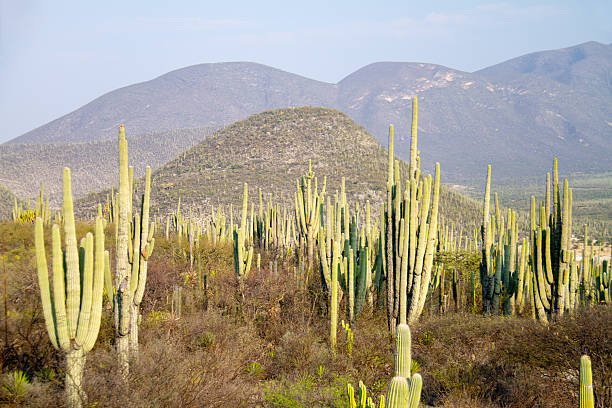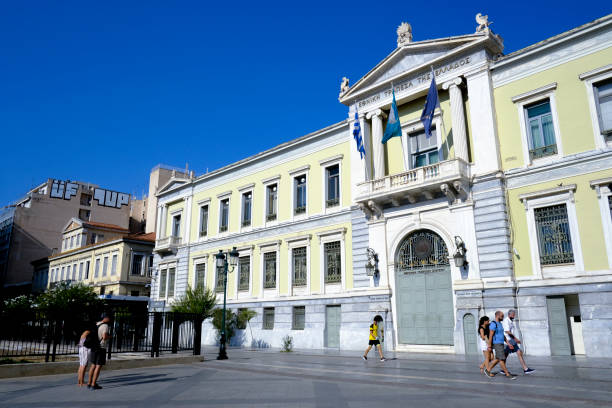Tehuacán-Cuicatlán Biosphere Reserve: A Biodiversity and Cultural Heritage Treasure in Mexico
The
Tehuacán-Cuicatlán Biosphere Reserve stands as one of Mexico's most
remarkable protected areas, spanning an impressive 490,186 hectares
across the southeastern state of Puebla and the northwestern region of
Oaxaca .
This vast territory, declared a UNESCO World Heritage Site in 2018
under the designation "Tehuacán-Cuicatlán Valley: originary habitat of
Mesoamerica," represents a unique convergence of extraordinary
biodiversity and profound cultural significance .
The reserve derives its name from its two principal locations -
Cuicatlán in Oaxaca and Tehuacán in Puebla, where the administrative
offices are situated .

What
makes this reserve particularly exceptional is its dual recognition as a
mixed World Heritage site, acknowledging both its natural wonders and
its archaeological importance .
This rare designation places it among only two such sites in Mexico,
sharing this distinction with the Calakmul Biosphere Reserve in Campeche . The reserve's boundaries
encompass 21 municipalities in Puebla and 30 in Oaxaca, creating a
complex mosaic of ecosystems and human communities that have coexisted
for millennia .
The
Tehuacán-Cuicatlán Valley forms part of the Mesoamerican region and
represents the richest biodiversity hotspot among all arid or semi-arid
zones in North America . Its
significance extends far beyond its borders, serving as a living
laboratory for understanding plant domestication, ancient water
management systems, and the evolution of human settlements in
challenging environments. The reserve's serial property consists of
three key components: Zapotitlán-Cuicatlán, San Juan Raya, and Purrón,
all sharing a common buffer zone of approximately 344,932 hectares .
Geographical and Climatic Characteristics
The
Tehuacán-Cuicatlán Biosphere Reserve occupies a dramatic landscape
where the broad Tehuacán and Cuicatlán valleys stretch northwest to
southeast, framed by the imposing Sierra Madre de Oaxaca to the east and
the Sierra Mixteca to the west .
This unique geographical positioning creates a rain shadow effect, with
the mountain ranges blocking many rain clouds from surrounding regions
and resulting in the area's distinctive semi-arid climate where average
annual rainfall measures only 380-400 mm .
The contrast between this arid environment and the humid climate of
nearby Veracruz, just a few hours away, is particularly striking .
Hydrologically,
nearly the entire reserve falls within the basin of the Salado River,
which flows southeastward through the Tehuacán and Cuicatlán valleys .
The Cuicatlán Valley also includes portions of the
northwestward-flowing Grande River basin, where these two rivers
converge to form the Santo Domingo River. This eventually joins the
Papaloapan, one of Mexico's most significant rivers .
The reserve's water systems are fed by numerous streams originating in
the neighboring sierras, creating vital oases in this otherwise dry
landscape .
Climatically,
the region presents a fascinating diversity shaped by its varied
topography. Approximately 73.57% of the reserve is classified as arid
and semi-arid, 24.64% as temperate humid and subhumid, and 1.79% as warm
humid and subhumid . This
climatic variation contributes significantly to the area's exceptional
ecological diversity. Visitors to the higher mountain areas frequently
encounter thick fog that occasionally condenses into light drizzle,
while the lower valleys experience warm semi-dry and warm semi-tropical
conditions, particularly in the Cuicatec region .
The
Sierra Madre de Oaxaca within the reserve consists of several
sub-ranges, including the Sierra Zongolica in the north, Mazatec Sierra
in the middle, and Sierra Juárez in the south .
These mountains are characterized by spectacular karst topography cut
by deep canyons, creating dramatic landscapes that alternate between
towering peaks and expansive valleys .
The reserve's elevation ranges create microclimates that support an
astonishing variety of plant communities, from arid scrublands at lower
elevations to cloud forests in the highest, wettest areas .

Ecological Significance and Biodiversity
The
Tehuacán-Cuicatlán Biosphere Reserve represents one of North America's
most important biodiversity hotspots, recognized by IUCN for its
concentration of endemic species, endangered species, and rare floristic
specimens . Contrary to common
assumptions about arid regions, this area boasts extraordinary
biological richness, with studies identifying it as a distinct Floristic
Province within the Mexican xerophytic Phytogeographical Region .
The reserve supports representatives of an astonishing 70% of worldwide
flora families and contains over 3,000 species of vascular plants,
about 10% of which are endemic to the valley .
One
of the reserve's most iconic ecological features is its spectacular
columnar cacti forests, representing the highest concentration of such
cacti in the world . Of the 70 columnar cactus species reported in Mexico, 45 are found in this central portion of the country .
These towering cacti create unique landscapes alongside agaves, yuccas,
and oaks, forming plant communities that are mostly endemic to
Tehuacán-Cuicatlán .
The reserve contains nine distinct plant communities dominated by
columnar cacti, with species ranging from the massive "candelabro"
(Pachycereus weberi) reaching up to 16 meters in height to the tiny
endemic Mammillaria hernandezii measuring just five centimeters in
diameter .
The
reserve's vegetation forms a complex mosaic that includes xeric
shrublands, tropical dry deciduous forest, pine forest, pine-oak
woodlands, and cloud forest .
The predominant flora in the Tehuacán Valley is scrubland or matorral,
part of the Tehuacán Valley matorral ecoregion, comprising more than a
third of recorded species . The
Cuicatlán Valley features tropical dry deciduous forest, an outlier of
the Balsas dry forests ecoregion, while the mountain slopes host oak and
pine-oak forests connected to the Sierra Madre de Oaxaca pine-oak
forests to the east and Sierra Madre del Sur pine-oak forests to the
west .
The
fauna of Tehuacán-Cuicatlán is equally impressive, particularly
considering the arid conditions. The reserve hosts 134 species of
terrestrial mammals (including two endemic to the valley), 353 bird
species (nine endemic to Mexico), 18 fish species, 27 amphibian species,
and 85 reptile species (20 of which are endemic) .
Among these are notable species such as the threatened Green Macaw (Ara
militaris), with the reserve containing one of Mexico's largest
populations of this magnificent bird - over 100 individuals recorded
since 2001 . Other significant
fauna include the tepezcuintle (Aguti paca), tigrillo (Leopardus
wiedii), river otter (Lontra longicaudis), lynx (Lynx rufus), and
various species of deer and squirrels .

The
reserve's importance as a global center for agrobiodiversity cannot be
overstated. It serves as a primary diversification center for numerous
plant groups, particularly cacti, with 28 genera and 86 species
represented, 21 of which are endemic .
The area also maintains an unusually high number of threatened species,
with about 38 listed under the IUCN Red List of Threatened Species .
This extraordinary biodiversity results from millions of years of
evolution in relative isolation, combined with the area's varied
topography and microclimates that have allowed species to adapt and
specialize in unique ways.
Archaeological and Cultural Heritage
The
Tehuacán-Cuicatlán Valley holds immense significance as an
archaeological site documenting an extraordinary 12,000 years of
continuous human habitation .
This lengthy occupation has left behind evidence of crucial
technological developments, including some of the earliest known
examples of plant domestication in the Americas and the continent's most
ancient irrigation works .
The valley's archaeological record reveals a complete sequence of human
adaptations to arid environments, making it one of the most thoroughly
documented cultural sequences in the Americas .
Among
the most remarkable findings in the valley are fossilized remains of
maize dating back to approximately 5000 BCE, discovered in Coxcatlán and
other sites in the region .
These archaeological treasures, associated with various stone tools,
were found in mountain shelters where the exceptionally arid climate
helped preserve organic materials that would have decomposed in more
humid environments . The Tehuacán
Valley is widely recognized as one of the primary locations where
humans first domesticated maize, squash, and beans - the foundational
crops of Mesoamerican agriculture .
The
valley's ancient inhabitants developed sophisticated water management
systems to cope with the arid conditions, creating what is considered
the most diversified ancient irrigation complex on the continent .
These technological innovations include an impressive array of canals,
wells, aqueducts, dams, and terraces that allowed agricultural
settlements to flourish in this challenging environment .
The development of these water management systems represents one of
humanity's major technological advances, alongside plant domestication,
both of which originated in this valley .
Throughout
its long history of human occupation, the Tehuacán-Cuicatlán Valley has
been home to various Mesoamerican cultures, primarily of Otomanguean
affiliation . Today, the reserve
hosts communities from at least eight indigenous groups: Mixtecs,
Cuicatecs, Ixcatecs, Nahuas, Chocholtecs, Popolocas, Chinantecs, and
Mazatecs .
These communities maintain profound traditional knowledge about the
uses of local plants for food, medicine, construction, and crafts,
knowledge accumulated over millennia of interaction with this unique
environment .
The
Popoloca people, who still inhabit the region, left behind stone ruins
and tombs within the reserve's boundaries that date back centuries .
These archaeological sites, though less known than major Mesoamerican
cities like Monte Albán or Teotihuacan, provide invaluable insights into
the daily lives and technological achievements of the valley's ancient
inhabitants. Visiting these ruins requires local guides, as they are
located in remote areas without marked trails .
The
cultural landscape of Tehuacán-Cuicatlán represents a remarkable
example of sustainable human-environment interaction. Traditional
practices such as palm and clay crafts, salt extraction, and the
sustainable harvesting of various fruits, seeds, leaves, and even
insects continue to this day, providing economic opportunities while
maintaining ecological balance .
These activities, combined with growing ecotourism initiatives,
demonstrate how conservation and human development can coexist
harmoniously in this fragile ecosystem.

Conservation History and Management
The
Tehuacán-Cuicatlán region's journey to protected status involved
several stages of recognition. Between 1995 and 1997, various portions
of the area were cataloged as state conservation areas before being
decreed as federal protected areas on September 18, 1998, by President
Ernesto Zedillo Ponce de León .
This established the Tehuacán-Cuicatlán Biosphere Reserve,
incorporating earlier state-protected zones like the Cuicatlán Valley
(1996), Tehuacán Valley, and Zapotitlán Valley (1997) as its core areas .
The
reserve's management represents a pioneering example of community-based
conservation in Mexico. According to the official declaration, local
inhabitants are permitted to continue traditional economic activities
provided they don't cause environmental deterioration .
This approach recognizes that human communities have been an integral
part of this landscape for millennia and that their traditional
knowledge and practices contribute to the area's conservation .
In 2012, the site gained further international recognition when it was declared a Biosphere Reserve by UNESCO .
The culmination of its global significance came on July 2, 2018, when
it was inscribed on the UNESCO World Heritage List as a mixed (natural
and cultural) site during the 42nd session of the World Heritage
Committee .
This dual designation acknowledges both the area's outstanding
biodiversity and its archaeological importance in the development of
Mesoamerican civilization .
The
reserve faces numerous conservation challenges, including climate
change, which poses significant threats to its delicate arid and
semi-arid ecosystems . In
response, management initiatives have implemented participatory water
quality monitoring programs involving local communities, reserve
leaders, and academics . These
collaborative efforts aim to address environmental challenges while
respecting the rights and needs of local populations.
Infrastructure
development has played a complex role in the reserve's history. The
construction of a superhighway in 1995 improved land connections between
Oaxaca City and Mexico City (570 km apart) but also introduced new
pressures on the ecosystem .
Current management strives to balance accessibility for visitors and
residents with the need to protect sensitive habitats and archaeological
sites.
The reserve's administration
operates under the principle of sustainable use of natural resources
(IUCN category VI), allowing for human activities that don't compromise
long-term ecological integrity .
This model has made Tehuacán-Cuicatlán a reference point for how
biodiversity conservation can generate opportunities for local people
while protecting fragile ecosystems .
Visiting the Reserve
For
travelers seeking to experience the wonders of Tehuacán-Cuicatlán, the
reserve offers unique opportunities despite some accessibility
challenges. Unlike conventional national parks with extensive trail
systems, much of the reserve lacks developed roads or marked paths,
making many areas inaccessible to casual visitors .
The primary accessible area is the Jardín Botánico Helia Bravo Hollis,
named after one of Mexico's pioneering biologists who specialized in
studying the region's succulents .
The botanical garden, open daily from 9:00 to 17:00, serves as an excellent introduction to the reserve's flora .
Entry fees are 90 pesos for foreigners and 45 pesos for Mexican
nationals, with optional guided tours available (tips expected for
guides) . The garden features
nearly 200 plant species representative of the broader reserve,
displayed in both cultivated settings at lower elevations and natural
wild growth at higher levels .
Visitors
can marvel at extraordinary specimens like the ancient beaucarnea
(succulents that can live for hundreds of years), various agave species,
and numerous cactus varieties including the towering tetecho columnar
cacti that dominate the landscape .
These giant cacti grow extremely slowly (about 10 meters in 140 years)
and have wood-like interiors traditionally used by locals for various
products . The garden's lookout
tower offers spectacular views of the surrounding "cactus forest," a
unique landscape found nowhere else on Earth .
For
those interested in archaeology, the reserve contains Popoloca ruins
accessible via a three-hour roundtrip hike with local guides
(approximately 350 pesos) .
Nearby, the town of Zapotitlán Salinas offers cultural experiences
including a 16th-century church and restaurants serving traditional
cactus-based cuisine, sometimes accompanied by salsa made with ants - a
local delicacy . The area's salt
flats, though not easily accessible without a vehicle or guide,
represent another facet of traditional resource use in the region .
The best time to visit is during the dry season from November to April when conditions are most favorable .
While public transportation options exist, renting a car provides
greater flexibility for exploring the reserve's scattered attractions .
A recommended three-day guided tour allows visitors to fully appreciate
both the ecological and archaeological wonders of this extraordinary
region .
Conclusion
The
Tehuacán-Cuicatlán Biosphere Reserve stands as a testament to the
incredible adaptability of both nature and human culture in the face of
environmental challenges. Its unique combination of spectacular
biodiversity, ancient archaeological sites, and living traditional
cultures creates a landscape of unparalleled scientific and cultural
value. As one of only two mixed World Heritage sites in Mexico, it
represents a crucial conservation priority not just for the nation but
for all humanity.
The reserve's
columnar cacti forests, endemic species, and evidence of early plant
domestication tell a story of evolutionary innovation spanning millions
of years. Simultaneously, its ancient irrigation systems and
archaeological remains document humanity's capacity to develop
sophisticated solutions for thriving in arid environments. Perhaps most
importantly, the continuing presence of indigenous communities
maintaining traditional knowledge and sustainable practices offers hope
for balanced coexistence between humans and nature in an era of
environmental crisis.
For
researchers, the reserve provides an open-air laboratory for studying
biodiversity, climate change adaptation, and sustainable resource
management. For visitors, it offers awe-inspiring landscapes and a
profound connection to the deep history of Mesoamerican civilization. As
climate change intensifies pressure on arid ecosystems worldwide,
protecting and learning from places like Tehuacán-Cuicatlán becomes
increasingly vital. This extraordinary biosphere reserve truly embodies
the interconnectedness of natural and cultural heritage, preserving both
biological evolutionary processes and the cultural traditions that have
shaped this landscape over twelve millennia of human presence.
Photo from: iStock














